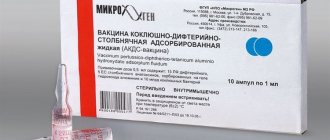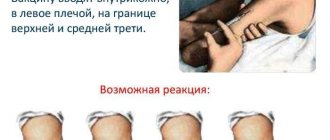For early diagnosis of tuberculosis, tuberculin is injected under the skin of children (less often adults), which shows the reaction of the immune system to the entry of antigens of this disease into the body. The name of this method is the Mantoux test. Based on the size of the developing papule (subcutaneous lump in the injection area), the doctor judges how successfully the patient has developed immunity to this disease. If there are rednesses of a certain diameter, one can judge whether antibodies are present in the child’s body, which began to be produced when the baby received the first anti-tuberculosis vaccination in the maternity hospital. Testing begins after the baby's first year of life.
An infiltrate forms at the injection site - a compaction. With normally developing immunity to tuberculosis, the body responds to antigens introduced under the skin; at the injection site, the activity of T-leukocytes already familiar with the infection is manifested, causing the formation of a papule. If there is no reaction to Mantoux under the age of 7, then parents should not be alarmed. The immune response to tuberculin is always individual in each specific case. It depends on the amount of Mycobacterium tuberculosis present in the blood and on a number of factors:
- individual tolerance of the drug;
- compliance with all rules of the procedure;
- the quality of the first BCG vaccine used;
- general health at the time of injection.
The norm is considered to be thickening and redness of the skin at the site of tuberculin administration. When there is no skin reaction to Mantoux in a child, then only taking into account all factors, including the results of an additional, more in-depth examination, the pediatrician concludes that the child is a carrier of the infection, suffers from tuberculosis or has normal immunity. If there is no manifestation of T-leukocyte activity, a repeat test is performed; it should confirm or refute the persistence of the negative immune response. The lack of immunity to tuberculosis will be visible when, after several attempts, there is no Mantoux reaction. If present, the antibody response is considered positive.
It is not normal to have redness on the skin without a papule.
If a negative result is recorded again, the patient is sent for additional examination, which will allow the doctor to make an accurate diagnosis.
What does this mean if there is no reaction to Mantoux?
Tuberculosis is a dangerous infectious disease.
Both adults and children participate in the comprehensive state program for its prevention and early diagnosis. All newborns are vaccinated with BCG. It protects the child’s still fragile body from the first days of life. Starting from the age of one year, children undergo annual procedure for checking the Mantoux reaction.
The test shows how successfully immunity against a dangerous disease is formed in a growing body. It is also used to diagnose tuberculosis infection.
Children receive their second BCG vaccination in primary school . It provides protection for another five to seven years. The effectiveness of vaccination is again monitored using Mantoux, the result makes it possible to find out whether infection has occurred within a year.
After reaching adulthood, Mantoux is replaced by another mandatory procedure - fluorographic examination . Adults are required to take it once every two years (or once a year if the nature of their work requires it).
Signs of a positive and negative reaction
Photo 1. Papule measuring 0.7 mm after passing the Mantoux test.
There is no reaction to Mantoux in a child, what does this mean, why does this happen?
In children, a comprehensive principle for assessing test results has been adopted.
Attention! A negative reaction to the Mantoux test in a one-year-old child who has been vaccinated with BCG is not normal . It is natural only if there is no scar. In other situations, additional diagnostics are required. The reason for the lack of response may be either the child’s immunity that has not yet formed due to his young age, or diseases that can destroy this immunity (for example, HIV).
- A small scar ( about 2 mm ) indicates that there has been no significant stress on the immune system in a child under one year of age. Protection against infection will last for another two years , then the immune system will forget the signs of the pathogen, and the reaction to the Mantoux test will become negative. The decision on the need for re-vaccination, after consulting with the parents, will be made by the doctor.
- A medium BCG scar ( about 5 mm ) will provide more reliable protection. In this case, the Mantoux reaction per year will be about 5 mm and will become negative by 4-5 years . But this is not necessary either. It is possible that the Mantoux index in all subsequent tests will be within the limits of a weakly positive ( 5-7 mm ) or doubtful ( 2-4 mm ) reaction. The main thing is that with each check before the secondary vaccination, the figure consistently decreases.
A particularly alarming sign is a negative Mantoux reaction in a child vaccinated in the maternity hospital at the age of two years.
By the end of the second year of life, the value of anti-tuberculosis immunity after vaccination becomes maximum. With a large scar ( 8 mm - 1 centimeter ), the sample size reaches 16 mm .
The average norm is about 10 mm . A negative reaction with a normal scar (and a previous result corresponding to the norm) must be checked additionally. There may be a disease associated with a general immune disorder.
By the age of six, most children will show a negative (or doubtful) reaction.
Reference . Before re-vaccination at the age of seven years, the normal indicator when checking the results of Mantoux becomes negative. She says that the child is not infected with tuberculosis. The immunity developed by the first BCG vaccination will expire by this time.
Only by the age of 13-14 does a negative Mantoux reaction become the norm again. If immunity has expired earlier, your doctor may recommend a booster shot.
No trace of Mantoux in adults
Photo 2. Negative reaction to the Mantoux test.
The subject of assessment and research when diagnosing unvaccinated patients is any reaction, any trace of an injection, including redness.
Important! When diagnosing infection or disease with tuberculosis, the diagnosis is never made on the basis of the Mantoux test alone. Additional tests and a comprehensive study are prescribed at the slightest doubt that the reaction to tuberculin is negative.
Indicators of a questionable result during diagnosis will be any redness and any size of the tumor. The infection may have occurred recently and cannot be missed.
Tuberculosis often occurs against the background of a general immune disorder. In this situation, a negative reaction to tuberculin is not an accurate diagnostic indicator.
A reduction in papules in children (up to a false negative reaction) occurs after taking antihistamines that can reduce the manifestations of post-vaccination allergies. If infection is present, the reaction will still remain positive.
It is unreasonable to achieve a negative Mantoux reaction; any manipulation with the result is dangerous and makes the procedure meaningless .
Who should not have the test: its possible complications and contraindications
The Mantoux test is not given to patients with certain diseases ( epilepsy, asthma, skin diseases ). It is not carried out at high temperatures, in the acute stage of any disease, in case of digestive disorders, poisoning, or respiratory diseases.
Allergies to the components of the diagnostic drug itself (primarily to phenol, used in small quantities as a preservative) are rare, but may be a reason to refuse the test.
How not to spoil the size of the button?
To ensure that the procedure for testing the Mantoux reaction does not drag on for many months and shows an accurate result on the first try, take the time to thoroughly prepare for it .
A week before your visit to the doctor, your diet Be sure to get examined by a therapist, and if you feel unwell, get a medical referral.
Clothing for an injection visit should be comfortable, spacious, made of natural materials (cotton), free of wool and lint.
the injection site , do not scratch or rub it, do not cover it with a band-aid or treat it with medications.
Useful video
The video explains what the Mantoux test is and explains the most common myths associated with it.
- Maxim - What parents of young children need to know: the norm of the Mantoux reaction at 1 year 5
- Olga - Parents are worried: what Mantoux’s reaction should be. The norm for children in size and color is 3
- Alina - It is important for any woman to know: is it possible to do fluorography during menstruation 3
- Elena - Attention to parents: what not to eat after Mantoux 5 vaccination
- Irina - Do you urgently need another vaccination after Mantoux? How soon can this be done? 5
What does this mean if there is no reaction to Mantoux?
Tuberculosis is a dangerous infectious disease. Both adults and children participate in the comprehensive state program for its prevention and early diagnosis.
All newborns are vaccinated with BCG. It protects the child’s still fragile body from the first days of life. Starting from the age of one year, children undergo annual procedure for checking the Mantoux reaction.
The test shows how successfully immunity against a dangerous disease is formed in a growing body. It is also used to diagnose tuberculosis infection.
Children receive their second BCG vaccination in primary school . It provides protection for another five to seven years. The effectiveness of vaccination is again monitored using Mantoux, the result makes it possible to find out whether infection has occurred within a year.
After reaching adulthood, Mantoux is replaced by another mandatory procedure - fluorographic examination . Adults are required to take it once every two years (or once a year if the nature of their work requires it).
Signs of a positive and negative reaction
Photo 1. Papule measuring 0.7 mm after passing the Mantoux test.
There is no reaction to Mantoux in a child, what does this mean, why does this happen?
In children, a comprehensive principle for assessing test results has been adopted.
Attention! A negative reaction to the Mantoux test in a one-year-old child who has been vaccinated with BCG is not normal . It is natural only if there is no scar. In other situations, additional diagnostics are required. The reason for the lack of response may be either the child’s immunity that has not yet formed due to his young age, or diseases that can destroy this immunity (for example, HIV).
- A small scar ( about 2 mm ) indicates that there has been no significant stress on the immune system in a child under one year of age. Protection against infection will last for another two years , then the immune system will forget the signs of the pathogen, and the reaction to the Mantoux test will become negative. The decision on the need for re-vaccination, after consulting with the parents, will be made by the doctor.
- A medium BCG scar ( about 5 mm ) will provide more reliable protection. In this case, the Mantoux reaction per year will be about 5 mm and will become negative by 4-5 years . But this is not necessary either. It is possible that the Mantoux index in all subsequent tests will be within the limits of a weakly positive ( 5-7 mm ) or doubtful ( 2-4 mm ) reaction. The main thing is that with each check before the secondary vaccination, the figure consistently decreases.
A particularly alarming sign is a negative Mantoux reaction in a child vaccinated in the maternity hospital at the age of two years.
By the end of the second year of life, the value of anti-tuberculosis immunity after vaccination becomes maximum. With a large scar ( 8 mm - 1 centimeter ), the sample size reaches 16 mm .
The average norm is about 10 mm . A negative reaction with a normal scar (and a previous result corresponding to the norm) must be checked additionally. There may be a disease associated with a general immune disorder.
By the age of six, most children will show a negative (or doubtful) reaction.
Reference . Before re-vaccination at the age of seven years, the normal indicator when checking the results of Mantoux becomes negative. She says that the child is not infected with tuberculosis. The immunity developed by the first BCG vaccination will expire by this time.
Only by the age of 13-14 does a negative Mantoux reaction become the norm again. If immunity has expired earlier, your doctor may recommend a booster shot.
No trace of Mantoux in adults
Photo 2. Negative reaction to the Mantoux test.
The subject of assessment and research when diagnosing unvaccinated patients is any reaction, any trace of an injection, including redness.
Important! When diagnosing infection or disease with tuberculosis, the diagnosis is never made on the basis of the Mantoux test alone. Additional tests and a comprehensive study are prescribed at the slightest doubt that the reaction to tuberculin is negative.
Indicators of a questionable result during diagnosis will be any redness and any size of the tumor. The infection may have occurred recently and cannot be missed.
Tuberculosis often occurs against the background of a general immune disorder. In this situation, a negative reaction to tuberculin is not an accurate diagnostic indicator.
A reduction in papules in children (up to a false negative reaction) occurs after taking antihistamines that can reduce the manifestations of post-vaccination allergies. If infection is present, the reaction will still remain positive.
It is unreasonable to achieve a negative Mantoux reaction; any manipulation with the result is dangerous and makes the procedure meaningless .
Who should not have the test: its possible complications and contraindications
The Mantoux test is not given to patients with certain diseases ( epilepsy, asthma, skin diseases ). It is not carried out at high temperatures, in the acute stage of any disease, in case of digestive disorders, poisoning, or respiratory diseases.
Allergies to the components of the diagnostic drug itself (primarily to phenol, used in small quantities as a preservative) are rare, but may be a reason to refuse the test.
How not to spoil the size of the button?
To ensure that the procedure for testing the Mantoux reaction does not drag on for many months and shows an accurate result on the first try, take the time to thoroughly prepare for it .
A week before your visit to the doctor, your diet Be sure to get examined by a therapist, and if you feel unwell, get a medical referral.
What to do if the body does not respond to the Mantoux test
The Mantoux test can be positive and negative in different situations. If the size of the “button” in children differs from the standard indicators, you should contact a TB doctor who will prescribe additional examinations or re-vaccination.
Additional diagnostic methods
If there is no reaction to Mantoux, the doctor may prescribe additional examination. One of these methods is PCR analysis for tuberculosis, which is carried out in anti-tuberculosis dispensaries. Another form of diagnostics is an analogue of Mantoux - Diaskintest. True, such a study will not tell anything about the success of vaccination, but it will accurately answer the question of whether infection occurred. If there are specific tuberculosis symptoms (prolonged cough, low-grade fever, intense sputum production), the phthisiatrician will prescribe a chest x-ray and bacterial analysis of sputum culture.
Most often, children at the age of 7 or 14 years after the Mantoux test undergo a planned revaccination with BCG. Usually after this the reaction is positive, since the protective function is restored after vaccination.
What does it mean if there is no reaction to Mantoux?
Many parents are concerned about the question: there is no reaction to Mantu, what does this mean and what measures should be taken? Pediatricians usually say that lack of response is bad. The body has not produced antibodies, so there is no protective reaction against the pathogenic Koch bacillus.
Why is the test done?
The World Health Organization recommends annual preventive screening in regions at high risk of contracting tuberculosis.
Many experts consider the manipulation harmless, the purpose of which is:
The Mantoux reaction depends on individual sensitivity to tuberculin, the correctness of the procedure, and the characteristics of the body. Each child may react differently to tuberculin. Therefore, the doctor must tell the parents everything about the Mantoux reaction before the procedure.
Often adults oppose testing for their children. But it is important to understand that this is the only way to diagnose an insidious disease at an early stage. Other methods have little information content.
If they get an injection and there is no reaction visible, parents worry whether it is good or bad. After all, the immune system does not react to tuberculin, which indicates its resistance or the absence of antibodies. If there is no trace of Mantoux, many factors are taken into account to determine an accurate diagnosis.
Negative result
If there is only an injection mark or a papule of no more than one millimeter on the skin, this indicates a negative result.
More often this result is observed for the following reasons:
The absence of a trace indicates a weakened immune system or the child has a predisposition to the disease.
Therefore, there is no need to draw conclusions on your own; only an experienced specialist can make a diagnosis. After all, a negative reaction can be observed in a healthy child, and can also indicate pathological abnormalities.
Having studied the dynamics of all previous samples, the doctor will make the correct diagnosis.
Other factors to consider when there is no response to the drug:
- if infected, you need to re-inject after two weeks if there is no trace;
- the child is under 3 years old, the immune system does not respond to tuberculin;
- the child is HIV-infected, often with Mantoux the dosage of the drug is changed or an additional Diaskintest test is done.
What influences the procedure?
There are a number of factors that influence the result of diagnostic testing:
These signs provoke a false reaction or its absence. It is necessary to properly care for the injection site. Before measuring the papules, it is forbidden to lubricate the skin with various ointments, brilliant green, do not comb, and it is better not to wet the graft.
Lack of response to the test is caused by the following disorders:
- the drug was administered incorrectly;
- used a low-quality needle;
- the result was deciphered incorrectly;
- The storage period has expired.
The test reaction is a kind of allergic manifestation, so the absence of allergies plays an important role. Individual intolerance to the component also occurs, and side effects are observed after manipulation.
Refusal of a diagnostic test
The procedure is not performed when there are contraindications:
- asthmatic attacks, epilepsy;
- rheumatism;
- allergic reactions to tuberculin;
- exacerbation of a chronic disease;
- acute forms of infectious diseases;
- quarantine at school or kindergarten.
If the contraindication is temporary, the manipulation is carried out after the child has fully recovered. Even a runny nose or slight cough can cause a false positive result.
It is prohibited to carry out the procedure together with other vaccinations within three weeks after vaccination.
Many parents refuse the test due to undesirable reactions after the administration of tuberculin.
But many experts consider this the only effective method for diagnosing tuberculosis. Nothing is prescribed based on one test; the diagnosis can be confirmed by additional research.
The attending physician must describe in detail the benefits of testing, possible complications, and identify contraindications.
After all, tuberculosis is an insidious disease that, without timely treatment, ends in death.
BCG cannot protect a newborn from infection with Koch's bacillus, but it can prevent severe complications.
It is important to recognize the disease at an early stage, which will prevent the proliferation of pathogenic mycobacteria. The Mantoux test allows you to diagnose the disease and identify problems with the immune system.
Therefore, refusal of the procedure shifts responsibility for the child’s health to the parents. It is important to monitor your health and avoid contact with infected people.
My son was given Mantoux in the garden today without warning. Well, that is, I wrote my consent a hundred years ago, and then we got sick 2 times. Well, they set it up and set it up. However, there was no trace left at the injection site. Just the injection point and that’s it. Previous times it was the other way around - there was a mark, there was redness, they explained that it was a normal reaction, but at the upper limit of normal. Who came across it? Maybe this is how it should be? I'll finish it by Monday. :)
The Mantoux test is performed on children to determine the need for BCG vaccination or revaccination, as well as the presence/absence of the disease. During it, the child is injected with tuberculin, to which leukocytes must respond. Based on the detected reaction, you can determine how well the vaccine works, as well as identify cases of tuberculosis.
Is the absence of a trace of Mantoux the norm?
After the test, a reaction (infiltrate) should appear at the injection site. It is also possible to detect slight redness around the wound. Sometimes there is no reaction after the test. Some people think that this is good, but it is wrong to think so. This means that the child’s body does not respond to the introduction of the drug.
The norm is the absence of a papule after the Mantoux test or its insignificant size. However, in practice, the complete absence of any external signs is rare. Usually, with a negative Mantoux reaction, a small compaction is observed on the patient’s hand. When there are no seals at all, this is also considered a negative reaction (or a variant of the norm), however, it is possible to say that such a result is good only after testing.
Despite the fact that sometimes parents object to Mantoux, its benefits are obvious, so the vaccination is always given before BCG revaccination. However, the lack of response makes diagnosis difficult, and doctors often prescribe a repeat procedure.
This result can manifest itself for various reasons, so it is necessary to take into account all the features and carefully study the anamnesis.
There may not be a trace of Mantoux due to the fact that the vaccination was given in the presence of contraindications. They may distort the results. Therefore, if Mantoux is done, but it is not visible, you need to make sure that there are no contraindications. Due to temporary contraindications, the procedure should be postponed; if there are absolute contraindications, it should not be done at all.
A questionable Mantoux reaction can be detected if the test is carried out incorrectly, or if the rules for handling it after the injection are violated. For example:
The grafting site was moistened with water during the first hour after it was carried out.- The mark was treated with an antiseptic, combed or steamed.
- Shortly before Mantoux, the child received other types of vaccinations.
- An infection entered the child’s body (immediately after the procedure).
All this can cause erroneous results, and the Mantoux reaction will not be visible. In other words, if there is no reaction to Mantoux, we can assume that this means a violation in the procedure. However, this does not always happen. In some cases, a reaction cannot be detected due to the characteristics of the patient's body or due to the characteristics of the vaccine itself.
Reasons for lack of reaction to the Mantoux test
A papule in a child may not appear after the Mantoux test for various reasons. Its absence is caused by:
- allergy;
- illnesses suffered the day before;
- lung diseases that can develop due to colds and weakened immunity in a child;
- other vaccinations;
- the presence of a parasitic infection in the body;
- external influences on the sample.
A negative test for tuberculosis in children is not necessarily an accurate indicator of the development of the disease. Perhaps she was influenced by:
- ineffectiveness of the first BCG vaccination, after which antibodies capable of fighting tuberculosis were not produced;
- the anti-tuberculosis vaccine was spoiled or the vaccination rules were violated;
- the baby has an unstable or underdeveloped immune system due to the presence of other diseases (including HIV).
If it is impossible to make a diagnosis based on the results of the annual Mantoux test, the doctor may prescribe another, more in-depth examination, the results of which will not be distorted by external factors.











